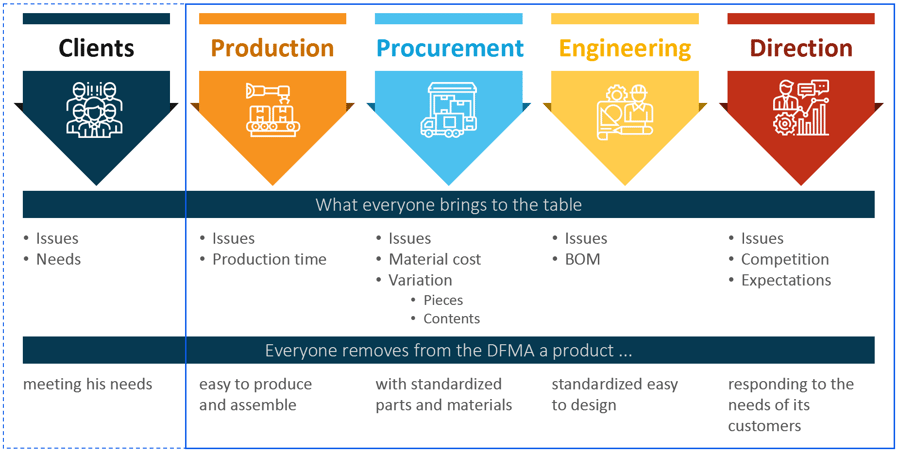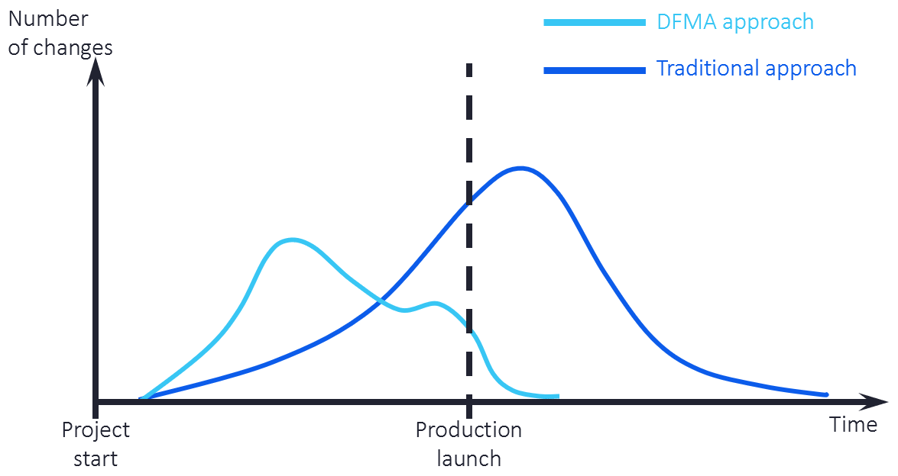Improve Your Products’ Performance with the DFMA Methodology
Does your organization finds itself in one of the following situations?
- Your products are performing for your client, but manufacturing them is sinking your productivity.
- Your engineering team is out of ideas as far as reducing the cost of production is concerned.
- You can feel the tension between the engineering team and the production team.
- Anticipated profits are just not happening.
If that's your case, the DFMA method would be able to give you a fresh start.
What is DFMA
"Design For Manufacturing and Assembly" (DFMA) or "Design for Manufacturing and Assembly" is an optimized design method that draws inspiration from both "design for manufacturing" (DFM), which aims to simplify the manufacturing process and reduce production costs, and "design for assembly" (DFA), which aims to reduce the number of components and operations in the final product design.
The goal of DFMA is to design a product in such a way that its manufacturing and assembly are simplified, leading to improved quality and reduced production and assembly costs, all while ensuring that it meets the required functions to satisfy the customer.
To succeed, there are three basic principles to a DFMA.
3 Fundamental Principles to DFMA
1. Reduce to a minimum the number of parts
Reducing the number of parts to account for in the process helps in several ways to reduce direct costs:
- In engineering, with fewer parts to design and manage.
- In storage.
- In production.
- In assembly, with a decreased number of parts to feed and assemble.
This will also have a positive impact on indirect costs, such as those related to administration and logistics (e.g., reductions in the number of parts to transport and/or order).
2. Standardize
Why would you need to reinvent the wheel when you can implement the same best practises already in place for other products?
Standardization means using the same components, hardware, and raw materials as much as possible in a product. It also involves the use of similar technical drawings for different products. This simplifies engineering’s tasks and prevents starting from scratch with each sale. Therefore, standardized parts are more financially attractive because they reduce design and production costs.
In general, the use of standards improves the efficiency and speed of production and logistics operations and allows for better service and products that match customer demand.
Limiting variation also reduces inventory, the number of kanban cards at workstations, and decreases the risk of errors. These are some of the reasons why standardization is essential in all of the company's products.
3. Facilitate input, handling and installation of parts
This concept of error-proofing parts, or Poka-Yoke in Japanese, was developed at the Toyota factory in the 1960s with the purpose of reducing or preventing human errors during production and logistics.
As a result, the parts designed during a DFMA activity should be easy to use, have only one installation direction, and a predetermined location to minimize errors in the factory.
A USB key is a good counterexample; few are those that can insert it into the port correctly on the first try. The tool is not optimized and leads to a loss of time.
4. Using Modular Design
Using modular design in your products allows for the repeated use of modules that make up the product in other items within the range while reducing costs. It's therefore possible to create various products with a common base, enhanced by modules with different functions. This enables quicker market placement while limiting the number of parts used. A battery can be identified as a module, and this module can be employed in various products. The product can be adapted based on the type of battery.
How a DFMA Initiative Should Be Carried Out
A- Learn all there is to know about your product in its current state
This first step must address three essential questions for the proper functioning of the DFMA method.
1. How much does the product costs?
The cost of materials is usually easy to find using the part list.
Whereas cost of labour, is more complicated to determine. A video analysis is often required to determine the cost per sub-assembly and per area.
2. What issues are affecting the product in its current state?
Among the issues surrounding products are:
- Those related to customers, what are their expectations.
- Those related to management, what policies have been decided (e.g., budgetary).
- Those related to procurement, who are the suppliers, what are the costs, etc.
- Those related to engineering, what type of design, etc.
- Those related to production, what is the workforce, what are the bottlenecks, etc.
As employees are often too close to the tree to see the forest, production issues often require being examined from the outside in. Operators adapted their methods to successfully manufacture complex parts. Assemblers developed templates and particular work methods to assemble the product.
3. What product characteristics contribute to meeting the client’s requirements?
A functional tree diagram allows matching each part to a specific function to which the product should correspond. These functions facilitate the optimization workshop and ensure that we focus on the client’s needs.

Image: DFMA Product Functions to Satisfy the Client’s Needs
B— Cross-functional workshops for product optimization
Every issues causing a problem must be solved during the optimization workshop.
Representatives from each department, of whom one is responsible for ensuring that client’s needs are met, are gathered as equals in the same room. During the workshop, a cross-functional team brainstorms solutions and designs that would allow solving the issues and improve the product.
 Image: DFMA Cross-Functional Workshops for Product Optimization
Image: DFMA Cross-Functional Workshops for Product Optimization
C- Validate new designs and prototypes
With several potential designs for each issue, enters the engineering team to further the thinking process and develop prototypes that will be revalidated along with the DFMA team.
Involving the same employees throughout the development process of a new product version helps reduce time to market since introducing new participants during that process means investing time in bringing them up to speed. Presenting the concepts to all the involved teams ensures the integration of all the necessary changes before the production launch.
 Image: DFMA Validate new designs and prototypes
Image: DFMA Validate new designs and prototypes
D- Launch product and validate results
Once the concepts and prototypes have been validated by the entire team, it’s now time to manufacture the new version. During the initial production phase, it's crucial to verify the projected improvements and make immediate adjustments if any final modifications are needed to complete the ultimate product version.
The Benefits of a DFMA Initiative
Engineering works on actual issues
Engineering teams are often asked to reduce the costs of products for the organization to be more competitive. Not having a profound knowledge of used manufacturing methods, and without any close relationships with the manufacturing facility as well as a focus on the cost of materials, designers do not know the impact of their changes on actual production.
With a DFMA initiative, the engineering team listens to the issues production employees are facing and works with them to rethink problem parts/sub-assemblies.
Getting the engineering and production teams to collaborate.
DFMA allow breaking down the wall dividing the engineering and the production teams erected because of the engineering team’s lack of time for product improvement, which has become the organization’s bottleneck. The initiative is a great opportunity for both sides to take the time and have an open discussion about developing a product that actually corresponds to everyone’s expectations.
Product Improvement Culture
A DFMA initiative allows involving employees and offering them the space to speak freely, to listen and solve the issues they face on a daily basis. Once the new version is being manufactured and employees notice how easy it is to assemble the product, issues pertaining to other products will appear as clear as a neon sign.
Do you think a DFMA initiative could be relevant to your products and organization?
Need to develop a DFMA initiative? Contact us!




